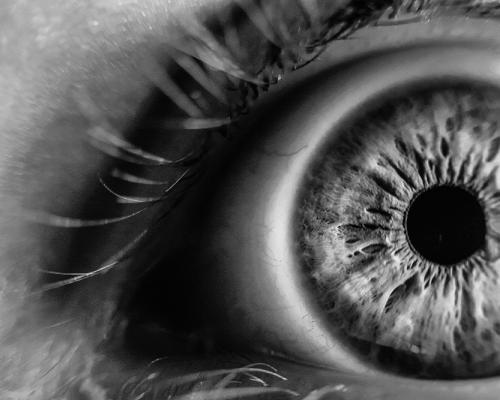Madness, creativity and human nature
Ivan Tyrrell talks with Daniel Nettle about the far closer than expected connection between psychosis and creative thinking.
Tyrrell: What were you trying to do in your marvelous book, Strong Imagination: madness, creativity and human nature? I read it on holiday this summer and I couldn't put it down. It really is brilliant.
Nettle: Oh, thank you. It's a book with an odd history. I started out aiming to synthesise a biological, more phenomenological understanding of mental disorder. However, I hit upon this link between creativity and the predisposition to psychotic conditions and that became the central argument of the book. It seemed to tie in so much about the way that the mental resources we use to generate many of the symptoms found in mental illnesses, including hallucinations, obsessions and so on, are the very same resources which the human mind uses when it is being most creative and producing what is generally regarded as the most healthy and elevated human activities. So the book became an opportunity to really look at how the biology and psychology link up psychotic conditions in a continuum with the healthy mind.
Tyrrell: Yes, that's one of the reasons I was so taken with it, and because this links in with our work. It seems to us, looking at the fossil record, that the ancestors of modern humans at some point made some sort of psychological breakthrough and began to use the imagination in new ways. There was an explosion in different types of tools and inventions, beautiful carvings appeared, etc. This must have had something to do with the discovery that we could focus our attention in a new way — daydreaming — and ask new types of questions and problem solve much more efficiently. However, with this powerful new mental tool came a vulnerability — as well as focusing our attention outwards imaginatively, to ask questions and solve problems, it meant we could also focus our attention back in on our own emotional responses and obsess about them in a way no animal before us could do.
Nettle: Absolutely. This capacity that humanity has to make representations of our own representations, is enormously powerful because it allows us to talk to each other about the future, the past, the absent and the mythological and the imaginary. But we can also hallucinate and obsess and become diverted into mental loops that are unhealthy for us. Clearly the psychological power of human imagination, when harnessed to a mammalian set of moods, needs and rhythms, can be wonderfully productive — and it also can go wrong. Both potentials are there.
Tyrrell: It seems to be on a continuum and that comes across in Strong Imagination. You wrote that "Any psychosis is a physical process. Thus it can be caused by any other physical process or event, be it a fencing foil, a hallucinogenic drug, or a prior brain state. The earlier brain state might, in turn, be caused by something in the social environment, since the activity of the brain is constantly changing in response to input from the senses and the body."
Nettle: Yes. That's right ...
Tyrrell: And that's a brilliant point because the genetic templates that are laid down have to seek their fulfilment in the environment. You call these genetic templates, or patterns, 'archetypal needs', and if they aren't being met in people's lives, for whatever reason — social disruption, brain damage, loneliness, etc — there's a strong likelihood that those disposed to psychosis are going to have breakdowns.
Nettle: That's right. I'm very keen, as I think many people are these days, to go beyond the 'biological' versus 'social causes' dichotomy. Of course, in one sense, every depression, for instance, is biological because one level of analysis of the phenomenon is that neural transmitters fire off stress hormones. We are biological creatures which means that, however we react, it will involve our biochemistry. Each person has a social history and a way of interpreting life events, which, in turn, affects their biology. There are just different layers of the same phenomenon that can all be investigated, rather than putting some depressions into one category and some into another.
Tyrrell: Yes, that's very clear. Can we talk about how mainstream psychiatric opinion describes, or categorises, schizophrenia?
Nettle: There have been many attempts to split schizophrenia into several subtypes, along the lines of symptom clusters, course of illness, or treatment response; these have not proved predictively valid.
The mainstream of psychiatric opinion would say that schizophrenia is a heterogeneous but none the less valid category of severe mental illness. The core features of it can be divided into three main types. First, there are the so-called positive symptoms. These are the bizarre beliefs, delusions, and hallucinations which popular imagination most often associates with schizophrenia. Typical features of positive symptoms include hearing alien voices in one's head, feeling that one's thoughts or speech are being controlled or manipulated by an outside force, or believing that neutral, outside events have a special significance referring to oneself (these are called ideas of reference).
In contrast to the positive symptoms are the negative symptoms, so called because they involve a diminution of emotion and motivation. The schizophrenic is often withdrawn, indifferent, and seems emotionally cold. He may be a loner. His range of interpersonal responses is much restricted. He has a reduced sense of purpose, and has difficulty setting himself goals and going about achieving them. In short, the schizophrenic's ability to perform acts of volition seems impaired.
The third category of symptoms involves subtle changes in patterns of perception or cognition. The effects of these changes are sometimes collectively known as 'divergent thinking' or 'loosening of associations'. Schizophrenic thought has a surreal feel about it, as connections are made which are quite bizarre from the normal point of view. When asked to sort pictures of objects into classes, schizophrenics often depart from those categories most intuitively accessible to the rest of us, such as 'tools' or 'fruit'. One research subject put together a bath plug, a padlock, and a circle of red paper "because all three stop flows or processes". Another put together a trumpet, an umbrella, and a whistle because all of them are, in some way, "noise-producing objects". Schizophrenic responses can be either abnormally concrete, as when a spanner and a screwdriver are put together because they are silver rather than because they are tools, or abnormally abstract, as when a coat and a dress are put together because they both "maintain human modesty", or air and water are put together because they are "states of molecular density". Either way, the perspective is unconventional.
Tyrrell: Was there any reason why you list the positive symptoms of schizophrenia first?
Nettle: No. I'm not seeking to privilege the positive symptoms except that schizophrenia is not diagnosed in the absence of those. They are considered to be necessary but not sufficient. The positive symptoms are very remitting and often don't appear for a long time. When they become extremely severe for a period, that's when a label of schizophrenia tends to get applied. But then they may remit again.
But it's clear to me that those symptoms are just one possible manifestation of a kind of psychological process which is probably much more insidious and which involves, as it were, a disorder of the pathways of cognitive activity — and probably emotional activity too — which may rumble on in a way that's more quietly disabling. So, for example, it may very badly affect social relationships for years and years before anyone says, "Look, this is schizophrenia", because everyone thinks, "Ah, schizophrenia — that's hearing voices or seeing things".
Tyrrell: I see.
Nettle: I think the core of the impediment is likely to be a kind of processing mode, or set, which can manifest as these symptoms but may also be there in some people who don't necessarily have the very obvious positive symptoms. I think we've got to look at people's patterns of attribution, causal reasoning and so on, when they're not having frank hallucinations and delusions. And typically you find that, in people who have had schizophrenia and are now in remission or under treatment, those still remain odd, even if the worse sort of hallucinations and delusions are not currently active.
Tyrrell: When you say 'odd' would they be similar to attributional thinking styles that you find in depression, for example?
Nettle: Not necessarily. What you often find in depressed people is a feeling that particularly negatively weighted events are the product of the self. They catastrophise, "It was all my fault that such and such went wrong". They seem to see very starkly that they have caused a whole load of terrible failures or disasters in their life —
Tyrrell: The typical 'all or nothing', 'black or white' thinking style depressed people exhibit when their thinking is being heavily influenced by the emotional brain operating out of the 'fight or flight' response —
Nettle: But, with schizophrenia, more commonly there's a different kind of reference to self which is to do with thinking that events or objects refer to, or have significance for, one's decisions in ways that most other people would say were completely unrelated. Paranoia can be one manifestation of that. As can ideas of reference. They might say, if they saw three blue lorries together on a Friday, for example, that it was obviously a sign to them from someone.
Tyrrell: Yes. I've recently been talking to a woman whose ideas of reference include seeing intense, sinister occult meaning in the colour scheme of a particular television commercial which involves the journey of a mouse. She is convinced this is a personal message to her containing some evil significance.
Nettle: I think this area between a schizotypy and certain types of supernatural belief is an interesting area to explore. If people can feel that certain phenomena in the universe are telling them something significant, sending signs to them, that, say, natural phenomena like thunder and lightening refer to them personally, it seems to me that we're not a million miles from how certain cultish religious beliefs get established.
The conscious mind is, in a sense, a narrator.
Tyrrell: Oh yes. You can see how superstitions and cult belief systems could take off when some people listen seriously to these sorts of ideas of reference!
Nettle: Absolutely! And clearly this comes back to our universal vulnerability to this kind of thing. In fact, it's a mode of talking which we find rather attractive. Hence the popularity of horoscopes and, if we see a black cat crossing our path, we might think that it refers to us when, in fact, a more rational analysis would be that the cat has nothing personally to do with us at all. This powerful inference-making apparatus we have is very good at detecting causal links, and perhaps a bit too good. Quite often, we're prepared to believe that this black cat crossing our path means that something bad will happen to us later, or something good. I think this stems from the development of the powerful mechanism for imagination that you describe — being able to go beyond the immediate — which our species obviously can do now.
Tyrrell: My colleagues and I are very interested in the role of dreams in distressed people. It comes up time and time again when you talk to them or read descriptions of how people feel when they are having breakdowns of various sorts — getting anxious, depressed or suffering in psychotic states. All these states seem to be connected to disturbances in the dreaming brain. Have you got any thoughts about that?
Nettle: Well, only that I think that it's an extremely interesting hypothesis. I've been around the schizophrenia literature for a while now and there is a kind of connection between hallucinations and dreams. One can't help but ask the question, are the voices and hallucinations that these people experience a kind of waking dream? But, as far as I can tell, it has never really been empirically investigated satisfactorily and it's something I'd be very, very interested in looking at further.
Tyrrell: Well, we've published information on the connection between dreams and depression which, when applied in psychotherapy and counselling, massively improves the speed with which one can lift depression.
Depressed people, as you know, dream a lot more than non-depressed people. We know this from work in sleep laboratories. They have disturbed sleep patterns and wake up exhausted because they have been dreaming for far more than the normal two hours a night. Depressed people get little recuperative slow wave sleep. Also, when the brain is dreaming, it uses an enormous amount of energy. Just before dreaming starts, there is a massive firing of the orientation response, known as the PGO wave, which is what draws our attention to things, like loud bangs, when we are awake, and activates the fight or flight response. In depressed people, it is firing off all night, creating dreams that metaphorically act out all the unresolved emotional arousals from the previous day, brought on by excessive negative introspection.
If the reasons for the excessive introspections don't go away — and one reason can be the attributional style of overly negative thinking about the ordinary ups and downs of life — long term depression sets in. It is this exhaustion of the orientation response, night after night, which creates the depression.
And this is the same orientation response that we need in the daytime to motivate action and purposeful thought, which provides the meaning for our lives. If the dreaming process is exhausted, life does seem meaningless. And that's how depressed people feel — even to the point where some of them kill themselves. All successful therapies, including antidepressant drugs, reduce dream sleep. That, we would say, is why they work.
Nettle: This is very interesting.
Tyrrell: We're coming to realise that stress, anxiety and depression seem to be on a continuum. Just as excessive environmental pressure can lead to depression, it can go on to trigger psychosis in those predisposed to it. Perhaps psychosis is the dreaming brain, not just exhausted as it is in depression, but so overloaded it invades daytime thoughts and activity to the point when the person can no longer tell the difference between a dream and waking reality. And so they have waking dreams — actually living and experiencing their dream metaphors.
I was speaking about this at a seminar recently, and a woman in the audience said, with tears in her eyes, that it made perfect sense to her because 17 years ago she had got extremely stressed and depressed about things going on in her life, and then collapsed into a psychotic breakdown which felt totally dreamlike. "I'm dreaming in the daytime," she kept saying to people, including her psychiatrist, but nobody took any notice of her! They just thought it was her madness talking.
Nettle: Yes, this is very interesting. And you do get this phenomenon, that I've seen clinically described, of people in psychotic states experiencing life in the way that we do in a dream where everything feels absolutely normal, but we also know is also very strange.
Tyrrell: Yes. While we're dreaming, it seems normal, doesn't it? The dreaming brain is a kind of reality simulator and we totally accept its reality while we are in it.
Nettle: Yes, and yet at the same time you are aware that this is something deeply unusual.
Tyrrell: Well, in lucid dreaming, for example, we can suddenly realise we are dreaming because a part of our mind knows that, say, we can't fly — so this must be a dream, and we become aware that it is.
Nettle: And exactly that ambiguity has often been reported in people's descriptions of the early stages of a breakdown. They are quite convinced that their hallucinations are real and normal, and indeed are part of everyday life, but they are also aware that they are not normal, and they really shouldn't tell other people about them because —
Tyrrell: Yes, it's as if part of the brain is still —
Nettle: — is still hanging in there. Yes!
Tyrrell: Not all of their mind goes into the waking dream.
Each person has a social history and a way of interpreting life events, which, in turn, affects their biology.
Nettle: I certainly think that a lot of the content of hallucination and delusion may come not so much from the pathological response itself, but rather from our conscious mind's attempt to say, "Well, look, you've got all this chaotic, unreleased cortical limbic activity going on; how can we give it narrative meaning?" The conscious mind is, in a sense, a narrator, I think.
Tyrrell: And that narrative has to be metaphorical. Dreams themselves, the narrative and the individual elements of them, are always metaphorical resolutions. And if it's the case that metaphorical dreaming plays such an important role in the brain, it follows that paranoiac and other hallucinations would also be metaphors for what's disturbing and stressing a person. Just as dream metaphors are wacky, and therefore seem absurd to the waking mind and other people, they are not absurd to the metaphorical mind.
Nettle: Now, that's what's so interesting. They are simultaneously metaphorical and also extremely concrete, and I think that's the paradox of the condition. Symptoms are metaphorical and represent, no doubt, tensions that are being worked through, yet the narrator has to apply a concrete substantiation. This means literally believing in the metaphor, as in the case of someone I knew who totally believed that there were white vans waiting round the corner with certain men in them. So, whilst the symptoms are metaphorical, I have no doubt that, at the same time, our conscious mind is thorough enough an interpreter and narrator to give them an extremely specific localisation in space and time — so that the person is not aware of their metaphorical nature and experiences them as entirely concrete.
Tyrrell: Yes, but I suppose that would happen if they were constantly slipping in and out of the REM state. When something is breaking up, you get bits, don't you?
Nettle: Yes, well, that's right. I've no doubt that the dreaming mind makes use of perceptual and memory resources. So, if it's dealing with memories of threatening-looking people, for example, it's going to give them a specificity drawn from the person's own memory and own perceptual maps and so on. And so it will put them in, for example, white Ford transits.
Tyrrell: Well, white van man can be pretty threatening!
Nettle: Ah, well, yes. In the beginning of my book I offered a case study of a Victorian gentleman, Mr Matthews, who had hallucinations. They are exactly the kind of thing a science fiction writer of those days would have written about. Back then, people thought that the future of technology was all pneumatic — all big looms with pedals and people in stovepipe hats leaning over them. And this is precisely what this man hallucinated because he was using the representations available in his culture, which the dreaming brain would make use of. So there is a link between creative culture, the creative process and the hallucinatory one. You have unresolved emotional activity and you attempt to give that a concreteness in the representations available in your culture and experience. Hallucination is a biological function and a cultural one.
Tyrrell: Your book is very convincing about the high degree of depression and mental instability in creative people — writers, poets, artists, pure mathematicians — people who are doing a lot of introspecting in their work. It seems as if introspection itself, which is necessary for creativity, is also a vulnerability. Could you talk a bit about what you discovered about the connection between creativity and mental illness?
Nettle: When I started out researching this area I was aware that there is a stereotype linking creative people with psychiatric symptoms, particularly of depression. I began to wonder if I would find anything beyond that stereotype. Now, I think the evidence is pretty good that groups of people involved in creative activity are very vulnerable and, in general, the more solitary and the more open-ended the creative process they are involved in, the more vulnerable they seem to be. While creative people in chemistry and the biological sciences obviously have moments of extreme theoretical abstraction, mostly they are working empirically in groups, solving problems which are well defined. So they have a slightly lower level of vulnerability.
By contrast, people in pure maths, and in poetry and in music composition, seem to have high levels of vulnerability. I think this is because, if you're a poet, a mathematician or a composer, the field is wide open. There are not many parameters when you sit down to work. It's not a case of, "Well, I've got to do this experiment and then count the numbers that come out of it". It's just me and the structures, the representations that I can create.
And that of course is incredibly pure and incredibly exciting but, as you say, it's deeply introspective, and the introspection need never terminate. Poetry, or making music, or doing pure mathematics, is never finished. There is always going to be something else to solve or express. There's always more you could do —
Tyrrell: — and more divergent possibilities.
Being unhappy is a strong predictor of later mental and physical illness. The niggling discontent will always out.
Nettle: So it does seem that there's a particular linkage between the most open-ended realms where you could speculate, or, as you say, introspect, in
a non-terminating way, and those realms where the outcomes are more constrained and practical.
But is it the creativity that's making these people depressed or the depression that's making them creative? I suggest a third alternative — that the types of people who, by virtue of both their nature and nurture, are drawn to creative work are also likely to be vulnerable to depression. So, if you like, I'm taking the person's disposition as the unifying factor of the two.
Tyrrell: That's interesting. The vulnerability of the more creative person is that their disposition is not to hold on to rigid structures in their minds. Creativity only happens if you can let go of old thoughts and rituals and conditioning. I would expect that you're not going to get many sufferers of, for example, obsessive compulsive disorders having psychotic breakdowns because they would be so obsessively controlling. But when nature seems almost to be pushing some people to be less dogmatic, more creative, to let go, the risk is they become more flaky in their creativity, and eventually this can lead to schizophrenia.
Nettle: That's true. Though I think that, when we do more research on the creative personality, we will find it is actually a very paradoxical disposition.
What some studies have reported is that successful creative people — those we know and talk about in our cultures and disciplines as being creative — somehow combine apparently conflicting characteristics of openness but also strong control. And I think that typically the creative process involves a phase of openness and then a phase of doing the 99 per cent perspiration. They work in a way that's more convergent. When they have conceived of something they then have to get it down, get the details right, work in a more constrained, practical way towards the realisation of their vision — the creative outcome.
And I wonder if one difference between people who ultimately have psychotic breakdowns and people who have some of those same tendencies, but become very creative, is the degree to which they are able to perform that second phase. Lots of creative people report spending a very small proportion of the year having their ideas, and a lot of time editing, sorting out material, reading around, doing no new creative work at all in fact, until they have produced whatever it is. And so I wonder whether there are people who can use that cognitive fluidity, can ride it for a bit and then say, "Well, yes, but now I'm going to sit down and actually turn that into a poem or a novel or a string quartet", rather than allowing it to circulate endlessly in the mind and go off into its own loop, which might lead to all sorts of structures in the person's mind but nothing in the outside world.
Tyrrell: I agree entirely. And there is another aspect to this too and that is that a lot of these creative endeavours are fairly lonely occupations.
Years ago, I commissioned 32 brilliant illustrators for a big book I was doing for an American publisher. They were producing beautiful, very detailed illustrations. Most of these illustrators would start work at 7 or 8am and work until midnight, and didn't see other people for hours on end. Whenever I went to see them, I noticed two quite distinct reactions. Some were so quiet that they could barely talk, as if they had lost the art of conversation. Others would just talk at me for an hour or two because they were attention starved. They had the control to stick with the work they were doing, but not having human attention did seem to make their brains go a bit peculiar. We all need a certain amount of attention every day, really.
Nettle: Yes, that's probably right. And another thing to remember is that the people who produce what culture judges to be very great achievements have typically produced a lot. Mozart, Schumann —
Tyrrell: Goethe, Shakespeare —
Nettle: Yes, as well as Shakespeare's plays being extraordinary, he was churning them out extremely fast. It's a pretty hit-and-miss business being creative, and you get much better the more effort you put in. There must be a strong compulsion to continue the work, and there are many creators who say that the compulsion is almost a medical condition with them. You know, "If I weren't doing this, I wouldn't know what to do when I got up in the morning. I'd go off my head." So, for whatever reason, these are clearly people who find their creative activity something to which they become strongly attached, and it allows them to release, or work through, divergent or chaotic activity that's going on within them. Which is almost a clinical hypothesis that could be investigated further.
Tyrrell: In the conclusion of your book you have given some 'golden rules' for people who are at familial risk of schizophrenia to follow, so that they can help themselves. They really show the importance of the environment in whether people are going to have problems or not. Perhaps, if we were better at spotting and treating depression earlier, society would have far fewer psychotic breakdowns to deal with.
Nettle: Yes, I'm sure that's right. And malaise more generally – substance addiction, social phobia, anxiety and anger disorders. Being unhappy is a strong predictor of later mental and physical illness. Individuals at high familial risk for psychosis, like all of us, should manipulate their own environments so as to maximise psychological health. That is, they should choose their surroundings, their companions, and their professional challenges very carefully, if need be with professional help from effective counsellors and psychotherapists.
The golden rules are: be honest, realistic, and loving with yourself and those around you; assume a positive outlook and make brave, positive life choices, going against the grain where necessary; listen to your body and keep healthy and active; and do not tolerate niggling discontent, even for a short time, and even if it seems minor.
The niggling discontent will always out; but whereas it might lead to a broken relationship or an unhappy career for most people, for vulnerable people, it can destroy them and those who love them in the most terrifying way imaginable.
This is not just an issue for individuals. In communities and social networks which are fragmented, stressed, or in which there is no sense of belonging, there are poorer outcomes and higher suicide rates for the mentally ill. This is something that social policy can work on. The existence of a biological predisposition thus in no way relieves us of the responsibility for doing something about mental illness.
Tyrrell: Yes, with better, what we call, 'organising ideas', people aren't going to be so bewildered when facing these conditions as they are at the moment. For example, because of the way most counsellors and psychotherapists are trained, the way depression is treated is largely appalling.
Nettle: Yes, it is.
Tyrrell: Genetic templates are there to meet their fulfilment in the environment. Genes are, at most, only 50 per cent of the story.
Nettle: That is quite so. And neurotransmitters. People often say, "Well, if it's a biological imbalance, only drugs can treat it", but you get a biological imbalance by sitting in a darkened room for a day.
Tyrrell: Of course! Or if someone gives you a hug, or makes you laugh, or you stretch your capabilities in some way, it changes the biology —
Nettle: Or going for a run or a swim or something. All these things are also chemical interventions.
Tyrrell: One of the really exciting things about your book is how well that comes across, particularly as summed up in the golden rules. I hope it gets the wide readership it deserves.
This article first appeared in "Human Givens Journal" Volume 8 - No. 3: 2001
 Spread the word – each issue of the Journal is jam-packed with thought-provoking articles, interviews, case histories, news, research findings, book reviews and more. The journal takes no advertising at all, in order to maintain its editorial independence.
Spread the word – each issue of the Journal is jam-packed with thought-provoking articles, interviews, case histories, news, research findings, book reviews and more. The journal takes no advertising at all, in order to maintain its editorial independence.
To survive, however, it needs new readers and subscribers – if you find the articles, case histories and interviews on this website helpful, and would like to support the human givens approach – please take out a subscription or buy a back issue today.
Latest Tweets:
Tweets by humangivensLatest News:
HG practitioner participates in global congress
HG practitioner Felicity Jaffrey, who lives and works in Egypt, received the extraordinary honour of being invited to speak at Egypt’s hugely prestigious Global Congress on Population, Health and Human Development (PHDC24) in Cairo in October.
SCoPEd - latest update
The six SCoPEd partners have published their latest update on the important work currently underway with regards to the SCoPEd framework implementation, governance and impact assessment.
Date posted: 14/02/2024












